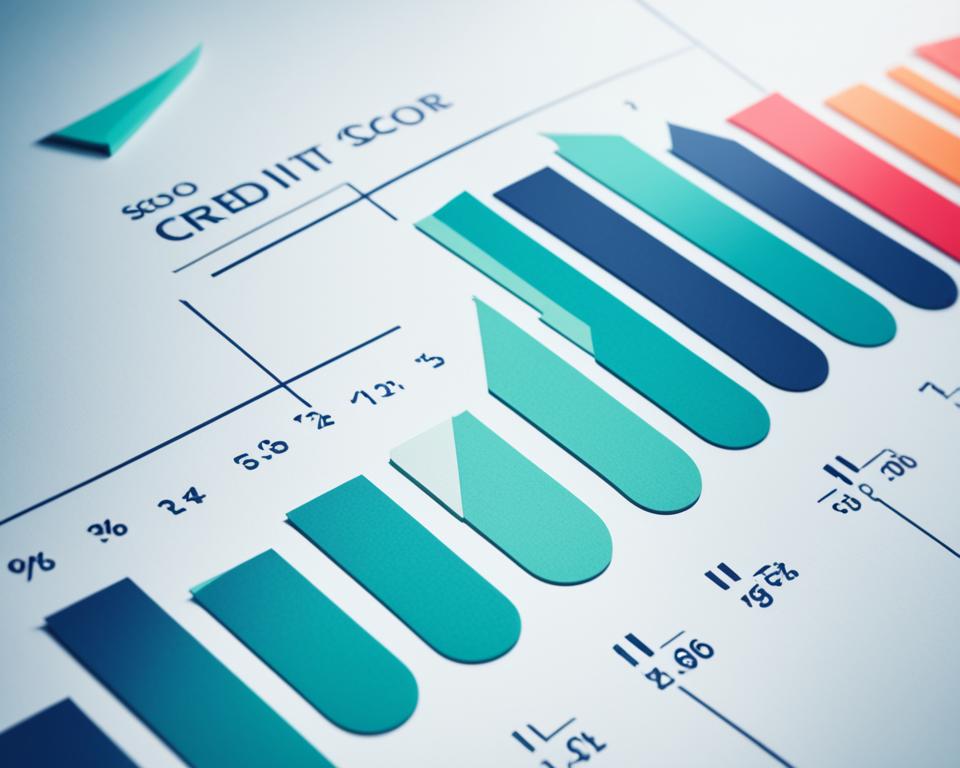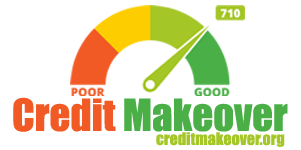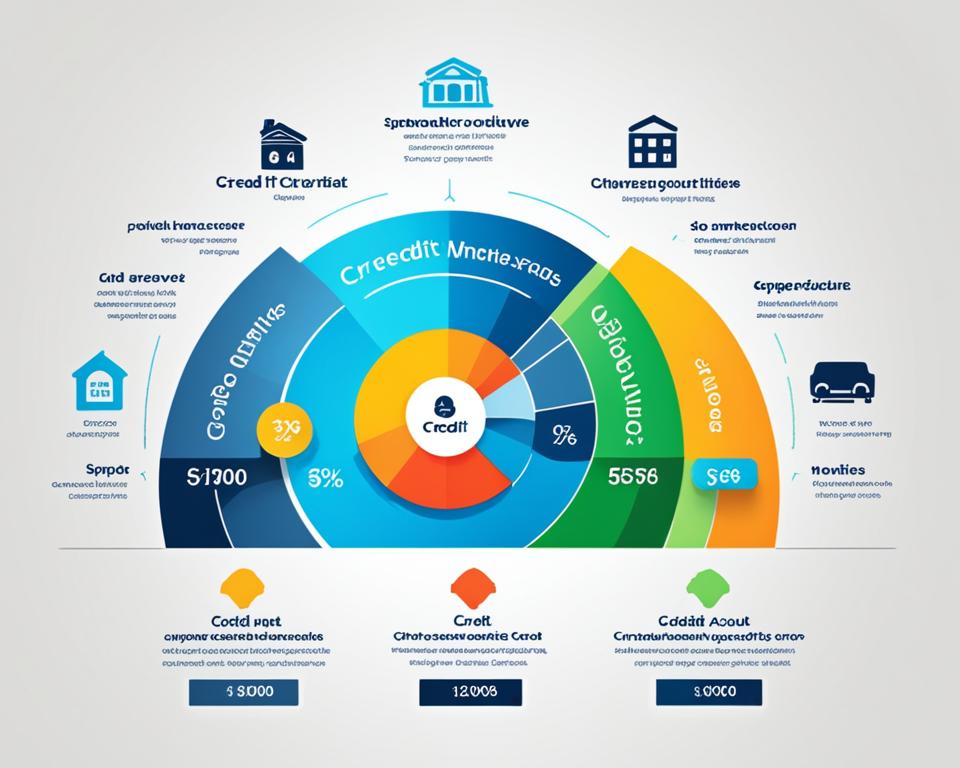Understanding your Credit Utilization is a significant aspect of managing your overall Credit Health. This potent marker represents the percentage of available Revolving Credit that you’re actively using and can profoundly shape your Credit Score. A well-maintained utilization rate, reflected by a lower percentage, resonates positively with fiscal agencies, paving the way for a robust FICO Score. It’s crucial to maintain an equilibrium between your utilized credit and the total Credit Card Balances, ensuring a sound reflection of your Financial Health.
Meticulous management of your credit utilization can offer a cascade of benefits, such as the ability to obtain additional credit with advantageous conditions. As we delve into the realms of personal finance, it becomes clear that a delicate balance in credit utilization is not just about reducing debt, but about optimizing available credit resources for a prosperous financial future.
Key Takeaways
- Credit Utilization can make up 30% of your Credit Score, highlighting its importance in credit evaluation.
- Instrumental in shaping Financial Health, a lower Credit Utilization rate is desirable for favorable lending opportunities.
- The FICO Score, which is paramount in lending decisions, is significantly affected by Revolving Credit practices.
- Maintaining a healthy Credit Card Balance is pivotal in achieving a desirable Credit Utilization ratio.
- Strategic Credit utilization speaks volumes about one’s financial acumen and potential creditworthiness.
- Understanding and managing Credit Utilization is indispensable for a positive and sound financial profile.
- A well optimized Credit Utilization rate is testament to responsible financial management and credit discipline.
Understanding Credit Utilization and Credit Scores
When it comes to Credit Health, one of the crucial measures is the Credit Utilization Ratio. This ratio bears significant weight in how credit bureaus and lenders evaluate financial soundness. A comprehensive grasp of credit utilization not only empowers you to improve your FICO Score Calculation but also serves as a barometer for your overall Debt-to-Income Ratio. As we explore the nuances of credit limits and scoring, we illuminate the path to adept credit management.
Essentials of Credit Utilization
The Credit Utilization Ratio is a metric that solely considers revolving credit accounts. These accounts encompass credit cards, personal lines of credit, and Home Equity Lines of Credit (HELOCs). Even accounts no longer in use but with remaining balances weigh in on the calculation, underscoring the importance of comprehensive credit limits management. To encapsulate credit utilization in your financial strategy is to sharpen a pivotal tool in enhancing creditworthiness.
The Role of Credit Utilization in FICO Score Calculations
The delicate art of FICO Score optimization greatly hinges on managing your Credit Utilization Ratio. This ratio is a substantial component, implying one’s dependency on credit resources and financial acumen. With the ideal usage falling below 30%—a figure deduced from national averages—it becomes evident that meticulous attention to Credit Limits and individual account balances is vital. This multifaceted consideration impacts scoring more than oft-perceived, marking its territory as a cornerstone of astute fiscal management.
| Description | FICO Score Impact | Good Practice |
|---|---|---|
| Overall Credit Utilization Ratio | Accounts for approximately 30% of your score | Maintain below 30% for optimal scoring benefits |
| Individual Account Utilization | Damaging if one account is highly utilized | Spread balances across accounts to avoid peaks |
| National Average Utilization | Guideline for individual financial health | Aim to stay below the national average (28% in Q3 2022) |
Credit Utilization and its intricate role in the FICO Score Calculation cannot be overstressed. It’s a testament to an individual’s fiscal responsibility—a beacon for creditors and a significant determinant of one’s financial journey.
Credit Card Balance and Its Importance
Maintaining a healthy Credit Card Balance is essential for safeguarding your Credit Health and keeping within acceptable Credit Limits. The balances reported by creditors to the credit bureaus play a pivotal role in the calculation of your credit utilization ratio, a metric critical to credit scoring methodologies. It’s therefore vital for individuals to understand the timing of these reports, as a high balance at the time of reporting could skew your utilization rate unfavorably.
It’s not uncommon for consumers to overlook the impact of a high Credit Card Balance on their scores. As lenders consider reported balances and not necessarily the up-to-the-minute figures, it becomes a strategic advantage to manage your balances proactively. By aligning payments with creditor reporting cycles, one can ensure a lower balance is reported, thus contributing beneficially to your credit utilization rate and, by extension, your Credit Health.
- Monitor balance against Credit Limits to prevent unhealthy spikes in utilization rate.
- Understand creditor reporting cycles to manage Credit Card Balance strategically.
- Plan larger expenditures or debt pay-down ahead of reporting dates for optimized credit reports.
- Maintain a running awareness of your credit utilization as part of ongoing personal financial reviews.
Below illustrates a comparison of two scenarios, where timely balance management before creditor reporting could result in a significantly healthier credit utilization ratio:
| Credit Card | Credit Limit | Balance Before Reporting | Balance After Reporting | Credit Utilization Ratio Before | Credit Utilization Ratio After |
|---|---|---|---|---|---|
| Visa Platinum | $10,000 | $3,000 | $1,000 | 30% | 10% |
| MasterCard Gold | $8,000 | $4,400 | $800 | 55% | 10% |
The table exemplifies how managing a Credit Card Balance before the reporting date can lead to a more favorable credit utilization ratio. This strategic approach to Credit Limits is a cornerstone of maintaining impressive Credit Health and is a testament to the financial prudence of the cardholder.
Credit Utilization and Its Effect on Your Score
The Credit Score remains one of the most critical determinants in financial opportunities and assessing Credit Health. In the intricate dance of numbers that constitutes your FICO score, Credit Utilization Impact cannot be underestimated. It’s a straightforward concept: how much of your Revolving Credit you use effectively forms a part of your credit score, and maintaining this balance is a cornerstone of good Credit Management. Here’s how it functions and why it’s so essential.

To paint a picture of credit utilization’s weightiness, think of it as carrying up to 30% influence on your FICO score. What this means is simple—high utilization rates can signal to lenders an over-reliance on credit, often leading to less-than-favorable impressions and subsequent credit score downgrades. On the flip side, showcasing lower utilization in your credit reports radiates responsibility, something creditors favorably incline towards, resulting in a potential boost to your score. Thus, the fine art of balancing credit usage emerges as a salient skill in the realm of finance.
Understanding your credit utilization goes beyond just keeping track of how much you owe. It’s about a comprehensive awareness of your financial standing and taking proactive measures to present yourself as a reliable borrower. Here, we will explore strategies and insights that can help maintain a healthy balance and ultimately improve your financial prospects.
Not only does credit utilization provide a glimpse into your current reliance on credit, but it also paints an evolving picture of your financial responsibility, shaping your credit history narrative with every transaction made, every balance paid off, and every limit cautiously not met.
Engaging in regular reviews and adjustments to your spending habits can ensure you remain within the golden parameters of credit utilization—ideally below 30%. It’s a financial trapeze act, maintaining the momentum, never swinging too far into the depths of credit, yet wisely utilizing available resources to keep the financial show going.
- Assess your revolving balances: Keep a pulse on what you owe and manage it judiciously.
- Monitor credit limits: An increase here can mean more breathing room for utilization percentages, but use this space wisely and without complacence.
- Spend mindfully: It’s the age-old wisdom of living within your means translated into the world of revolving credit.
- Pay down balances strategically: Timing can be everything when it comes to how a reported balance affects your utilization rate.
In conclusion, Credit Utilization shapes the very fabric of your Credit Score. This potent metric reflects your credit behavior and is a pivotal component that lenders scrutinize. Taking command of your utilization not only improves your current financial situation but also sets a solid foundation for future creditworthiness.
Components of Credit Utilization Ratio
Delving into the dimensions of Credit Utilization Components, we unearth the critical elements that collectively determine your credit profile’s vitality. Central to this exploration are the influential Revolving Credit Accounts, which embody more than just your conventional credit cards; they extend to the varied spectrum of personalized lines of credit, cementing their significance in the credit utilization milieu.
Revolving Credit Accounts Influence
The cornerstone of credit utilization, revolving credit accounts, are a mainstay in the calculation of your credit ratio. A revolving credit account is a flexible financing tool that grants users the ability to borrow funds up to a certain limit, pay off the debt, and borrow again. From well-known credit card companies like Visa and MasterCard to retail store cards and gas cards, these financial instruments stand as testament to your ability to manage and repay debt. Their pivotal role emphasizes the necessity for astute supervision of credit and an understanding of each account’s sway over your total available credit. It’s this equilibrium of accounts and the balance they carry that frames a comprehensive picture of personal financial solvency.
HELOCs and Their Impact on Credit Utilization
Escalating the discourse on credit utilization, Home Equity Lines of Credit, or HELOCs, emerge as a dominant force with a profound HELOC Impact on one’s fiscal standing. They differ from conventional revolving credit in that they are secured by the borrower’s home, offering substantially higher credit limits given the collateral involved. The magnitude of a HELOC means that its balance can sway your credit utilization ratio quite significantly. Prudent management of such lines, primarily due to their potential to either elevate or depress a credit profile, becomes imperative.
A balanced integration of HELOCs into one’s financial strategy, while ensuring that revolving credit accounts are judiciously utilized, can establish a robust foundation for excellent credit. Here below is a brief tabulation illustrating how various credit options factor into the overall credit utilization puzzle:
| Account Type | Role in Credit Utilization | Impact Considerations |
|---|---|---|
| Credit Cards | Mainstay of revolving credit | Directly correlates to spending habits and payment discipline |
| Authorized User Accounts | Factors into total available credit | Can indirectly influence credit utilization based on primary user’s activity |
| Personal Lines of Credit | Flexible borrowing option | Utilization can vary widely based on individual needs and repayment practices |
| HELOCs | Secured by real estate assets | Given higher credit limits, management is key to maintaining healthy utilization rates |
With each component bearing distinct influence on your total credit landscape, a well-rounded approach to managing these accounts is pivotal. Complete financial equilibrium is attained not merely through low utilization but through strategic calibration of each revolving account and its respective balance, reflecting both the volume and maturity of your credit practices.
Optimizing Your Debt-to-Income Ratio
Striving for excellent Financial Health is an ongoing process that involves various aspects of fiscal management, one of which is the Debt-to-Income Ratio. This metric provides a clear-cut percentage, comparing your monthly debt payments to your gross monthly income. To ensure the best possible terms from lenders, it’s essential to maintain this ratio at a reasonable level. Also crucial is Credit Utilization Optimization, which goes hand-in-hand with the debt-to-income ratio to present a fuller picture of financial responsibility.
The key to optimizing your debt-to-income ratio lies in meticulous budgeting and managing your debts effectively relative to your income. This entails keeping a vigilant eye on your monthly obligations—such as mortgage, car loan payments, and your revolving credit balances—to ensure they don’t eclipse your monthly earnings. Achieving a lower debt-to-income ratio signals to potential creditors that you are less of a risk, making you more likely to secure credit under favorable conditions.
Together with a judicious approach towards spending and borrowing, smart Credit Utilization Optimization techniques can facilitate robust Financial Health and stability. Balancing credit usage by maintaining lower balances on credit cards and other lines of credit optimizes your credit utilization, thereby enhancing your credit score and augmenting your ability to manage debts efficiently against your income.
One effective strategy for sustaining a healthful debt-to-income ratio involves making additional payments towards your debts, which not only reduces your credit utilization but also cuts down on interest costs over time. Equally, increasing your income, through methods such as secondary income streams or negotiating a salary raise, can help improve your ratio and enlarge your financial opportunities.
- Consolidate your debts with a lower interest rate loan—this could lower your monthly payments, thereby enhancing your debt-to-income ratio.
- Avoid taking on new debt that is not absolutely necessary, as this can unfavorably tip your balance between income and debts.
- Pay more than the minimum on your credit card balances each month to reduce your Credit Utilization and hence support better credit scores.
- Keep track of your financial progress by reviewing your debt-to-income ratio regularly, making timely adjustments as your financial situation evolves.
A balanced approach to debt, credit, and income not only exemplifies sound financial planning but also fosters a stable economic environment conducive to growth. Through vigilance and regular financial check-ins, optimizing your Debt-to-Income Ratio becomes an achievable goal en route to overall financial wellness.
Calculating Your Personal Credit Utilization Rate
Gaining a deeper understanding of your Credit Utilization Calculation begins with obtaining a current copy of your Credit Report. Through meticulous Credit Report Analysis, you are able to uncover the balances and limits of your Revolving Credit Balances. This pivotal intel lays the foundation for calculating and subsequently managing your credit utilization rate.
Finding Your Credit Report Details
To embark on the journey of personal credit utilization analysis, you must first locate the details of your revolving credit accounts. These details, available in your credit report, include your current balances as well as your total Credit Limits. These figures are integral in assessing how much of your available credit has been utilized, a key factor that credit bureaus evaluate when determining your creditworthiness.

The Mathematical Breakdown of Utilization Calculation
The calculation of your personal credit utilization is straightforward yet powerful in its implications for your financial health. By dividing your total revolving credit balances by your total credit limits, and then multiplying that number by 100, you arrive at a percentage that clearly indicates your credit utilization rate. This percentage is a clear indicator of your engagement with available credit and can be pivotal in guiding effective credit management decisions.
- Sum up all balances on your revolving credit accounts.
- Add together the credit limits available on these accounts.
- Divide the total balance by the total credit limit.
- Multiply that result by 100 to get your credit utilization percentage.
Strategies for Maintaining Good Credit Utilization Ratios
The path to Credit Score Improvement is underpinned by effective Credit Utilization Strategies, which are fundamental to sound Financial Planning. A lower credit utilization ratio can have a beneficial impact on your credit standing, so let’s explore concrete tactics to optimize this vital metric.
One strategy for managing your utilization ratio is to pay off credit card balances prior to the reporting date. Not only does this reduce the amount of credit you’re reported to be using, but it can also save you on interest and bolster your financial profile.
Another effective approach to better credit health is to request an increase in your credit limits. If you have a history of timely payments and responsible credit management, your creditors may be willing to extend your available credit, lowering your utilization ratio as a result.
Keeping your lenders informed of any increase in your income can also indirectly help you maintain a lower credit utilization ratio. As your income grows, creditors may be more inclined to offer you higher credit limits, considering your improved capacity to repay.
Consolidating your revolving credit into an installment loan is an advanced technique that has a dual benefit: it can not only lower your revolving utilization ratio but also diversify your credit mix, which may positively affect your credit score.
A strategic and often overlooked tactic is judiciously applying for new lines of credit to increase your available credit. However, it is vital to avoid accumulating balances that could negate the utilization ratio improvement this new credit provides.
Lastly, it’s essential to resist closing unused credit cards as they contribute to your overall available credit, and thus keeping them open, provided they don’t cost you in annual fees, can help maintain a favorable utilization ratio.
The following table outlines some of the key strategies and their benefits:
| Strategy | Benefit | Impact on Credit Utilization |
|---|---|---|
| Early Balance Payoff | Reduces reported balance and interest | Lowers utilization ratio |
| Credit Limit Increase | Increases available credit | Lowers utilization percentage |
| Income Reporting | Potential automatic credit limit review | May lead to a higher credit limit and lower utilization |
| Debt Consolidation | Combines revolving credit into an installment loan | Reduces revolving balance and improves credit mix |
| New Lines of Credit | Expands credit availability | Potentially lowers overall utilization if managed well |
| Keeping Unused Cards Open | Preserves credit limit of dormant accounts | Contributes to a lower overall utilization ratio |
In summary, active management of your credit card usage through various strategies can lead to a sustained improvement in your credit utilization ratio. This proactive approach is a testament to the significance of financial acumen in Credit Score Improvement and overall Financial Planning.
Improving Credit Health by Managing Utilization
Attaining a stronger financial standing involves proactive Credit Health Improvement tactics, a focal point of which is astute Credit Utilization Management. By meticulously assessing and refining the amounts owed on revolving credit lines, individuals can signal to lenders their proficiency in financial stewardship. In the larger context of personal finance, this strategic approach to credit balance and limit alignment stands as a pillar in bolstering one’s fiscal reputation and unlocking future credit opportunities with competitive terms.
This journey towards optimized credit health not only manifests in numeric reductions on monthly statements but also in the vigilance and adaptability in how one contends with fluctuating Credit Utilization Ratios. Here, the intertwining of disciplined credit conduct and consistent Revolving Credit Monitoring constructs a bedrock for creditworthiness, influencing lenders’ willingness to offer beneficial credit options and rates.
Importance of Proper Utilization for Credit Health
Crucial to understanding credit’s complex weave is the recognition of proper utilization as a cornerstone of Credit Health. Each swipe, each charge, conjures a ledger entry that is scrutinized under the microscopic gaze of credit bureaus, with the Credit Utilization Ratio enjoying a significant spotlight. Keeping this ratio within an advantageous range is tantamount to presenting a veneer of fiscal responsibility and can often be the deciding factor in obtaining preferential credit terms and approvals.
Monitoring and Adjusting Your Ratios
To refine and maintain a healthy Credit Utilization, consistent monitoring is non-negotiable. With dynamic changes in credit lines and spending practices, it becomes imperative to wield the tools of modern finance—such as reliable credit monitoring services. These services offer more than mere snapshots of financial standing; they provide a weekly cadence of updates, shedding light on utilization percentages and forecasting their potential impacts on credit scores.
Awareness burgeons into proactive adjustment as individuals grasp the dials of their credit machinery, recalibrating their ratios in ready response to life’s financial undulations. It’s not about steadfast fixation on a singular number but about the fluid and timely management of ratios, establishing and safeguarding one’s position on the credit spectrum.
- Utilize alerts and notifications from credit monitoring platforms to stay abreast of credit utilization fluctuations.
- Implement financial check-ins to realign credit use in accordance with personal budgets and limits.
- Embrace the practice of early payments to mitigate high utilization impacts pre-reporting to bureaus.
- Seek opportunities for limit increases or strategic credit line additions that complement the utilization strategy.
These maneuvers in the theater of personal finance, constituting what can be likened to an ongoing balancing act, require keen insight and dedication. It is through these measures that one can envisage a gradual ascendancy in credit health, securing a firm foothold on the path to credit glory.
Impact of Individual Account Versus Total Credit Utilization
When dissecting the Credit Score Factors, the significance of balancing Individual Account Utilization with Total Credit Utilization shines through as a complex, yet essential strategy. Credit scoring models take both into account, underscoring the importance for individuals to not only focus on their overarching credit usage but also to keep a vigilant eye on the utilization rates of each individual account.
The relationship between these two facets of credit utilization is an intricate one. A single credit account pushed to its limit can cast a shadow on your financial reputation, even if the cumulative utilization across all accounts seems under control. Thus, a profound grasp of managing both individual account thresholds and the aggregated credit capacity becomes pivotal.
Let’s explore how they both independently and collectively influence your credit score:
| Credit Utilization Type | Description | Impact on Credit Score |
|---|---|---|
| Individual Account Utilization | A measure of the percentage used on a single credit line | High utilization on one account can significantly decrease credit scores |
| Total Credit Utilization | A cumulative measure across all revolving credit lines | A balanced ratio suggests responsible credit management and can improve scores |
| Interaction Between Types | How individual account utilization aligns within total credit usage | A harmonized approach optimizes credit scores by indicating adept financial handling |
Managing Credit Utilization is a key component to credit maintenance and depicts how adeptly a person can juggle multiple credit lines without tipping over. What becomes apparent is – managing your utilization is more than just keeping numbers low; it’s about maintaining an equilibrium that responsibly displays credit use, both individually and collectively.
Each credit card in your wallet comes with its own chorus in the symphony of your financial narrative. It’s not the loudness of one but the harmony of all that creates a masterpiece admired by lenders.
By understanding the intrinsic value and impact of Individual Account Utilization versus Total Credit Utilization, you can sculpt a credit score that not only opens the gates to future financial avenues but also stands as a testament to your credit savvy.

Demystifying Good Versus Bad Credit Utilization Rates
Navigating through the realm of credit, it becomes imperative to differentiate between good and bad credit utilization rates. The distinction holds significant sway over your credit scores, and understanding these parameters is a key step toward maintaining financial stability and health.
What Constitutes a Good Rate?
A good credit utilization rate is one that aligns well within the prescribed credit utilization thresholds, generally acknowledged to be below 30%. This benchmark is not just a random number but a reflection of responsible credit management. Maintaining credit utilization rates in the low single digits is often seen as an indicator of exceptional credit conduct and positions individuals favorably for future financial considerations.
Understanding How Rates Affect Credit Scoring
The effect of utilization on credit scoring is significant and multifaceted. As credit balances inch above the 30% mark, credit scores can begin to reflect the change unfavorably. Consequently, it’s not just about achieving any “good” number; it’s about striving to remain below crucial credit utilization thresholds that have been empirically linked to healthier credit standings. Such vigilance ensures credit use appears calculated and controlled, uplifting the impression one’s credit profile casts upon potential lenders.
Grasping the essence of a good credit utilization rate involves more than adhering to a numeric guideline; it involves an understanding of the intricate interplay between one’s revolving credit practices and the resultant influence on their credit scores. It highlights a commitment to fiscal responsibility and prudent financial maneuvering, objectives cherished in the sphere of personal finance.
Trends in Credit Utilization and FICO Scoring Models
The financial landscape is always progressing, and with it, the mechanisms used to calculate credit scores evolve. Notably, Credit Utilization Trends have taken center stage in the advancements of FICO Scoring Models. In recent times, there has been a marked shift towards incorporating trended credit data, leading to the development of sophisticated models such as VantageScore 4.0 and FICO 10 T.
These modernized scoring models stand out from their predecessors by considering a broader view of a borrower’s financial behaviors over time. By incorporating patterns in credit card balances and utilization ratios, these models are set to create a more informed picture of creditworthiness.
Let’s explore through the table below how the new models compare against older generations in assessing credit utilization:
| Scoring Model | Data Consideration | Utilization Trending | Implications for Borrowers |
|---|---|---|---|
| Older FICO Models | Mostly recent balances | Not Applicable | Short-term focus could penalize temporary balance spikes |
| VantageScore 4.0 | Trended data over two years | Applicable | Long-term credit management habits are rewarded |
| FICO 10 T | Trended data snapshot | Applicable | In-depth analysis of borrowing patterns over time |
As can be seen, the introduction of VantageScore 4.0 and FICO 10 T marks a paradigm shift in credit evaluation. Historically, FICO scoring models would evaluate credit utilization at a single point in time. Now, there is a recognition that the financial paths of borrowers are not always linear. A glimpse into trends provides a more dynamic assessment, potentially leading to fairer evaluations of those who are working actively towards improving their credit health.
Understanding these Credit Utilization Trends is crucial for individuals looking to navigate the changing tides of credit scoring. Especially given that credit utilization accounts for a sizable portion of one’s credit score, staying informed on how these models assess their financial behaviors becomes invaluable. By adapting to the nuances of the latest FICO Scoring Models, borrowers can more strategically manage their credit and better posit themselves for favorable lending decisions.
Ultimately, the current trajectory in credit score modeling underscores the importance of maintaining good credit habits over an extended period. It draws attention to the reality that in the domain of personal finance, consistency is key.
Lowering High Credit Utilization Before It Affects Scores
Addressing high credit utilization swiftly is essential for maintaining credit score health. Various Credit Management Techniques exist that enable individuals to effectively reduce their utilization levels. Implementing these can lead to Quick Credit Score Recovery, safeguarding one’s ability to qualify for loans or credit with better terms. By staying ahead of high utilization rates, you can prevent potential negative impacts on your credit scores and enjoy the financial flexibility that comes with a robust credit reputation.
Techniques to Quickly Decrease Utilization Levels
To achieve the goal of Lowering Credit Utilization, one can adopt several practical steps that provide immediate results. These measures are specifically designed to reconfigure the debt-to-credit ratio in a favorable direction. By leveraging these actions, individuals can exert control over their financial profiles, keeping credit score dips at bay.
- Enhance credit limits: Requesting increases on current credit card limits can instantly decrease your utilization percentage, provided that spending doesn’t grow in tandem.
- Accelerate payments: Paying off credit card balances ahead of billing cycles reduces reported balances, thus improving utilization ratios, and in turn, credit scores.
- Consider new credit options: Opening additional lines of credit can boost the total available credit, although this should be approached with caution to avoid future debt accumulation.
- Strategize balance distribution: Spreading the debt across several cards can help avoid any one card showing high utilization, maintaining a balanced credit report.
The Immediate Benefits on Credit Scores
The impact of these strategies on credit scores can be quite immediate. Credit bureaus usually update credit reports regularly, and lower balances or increased credit limits are reflected shortly after they are reported by creditors. This quick reflection in one’s credit report can facilitate swift improvements in credit scores, amplifying borrowing power and financial standing. The strategic approach to credit card management is what enables such rapid transformations in one’s credit-utilization narrative.

Understanding approaches to Lowering Credit Utilization is crucial, and executing these tactics effectively could mean the difference between financial restriction and freedom. It is one of the most impactful Credit Management Techniques for Quick Credit Score Recovery, letting you tread the path of financial opportunity with confidence.
| Technique | Description | Immediate Impact on Credit Score |
|---|---|---|
| Credit Limit Increase | Requesting a higher limit on existing credit cards. | Possibly significant, as it lowers overall credit utilization. |
| Accelerated Payments | Paying balances before they are reported to credit bureaus. | Can rapidly improve utilization rate and credit score. |
| New Credit Lines | Opening new lines of credit to increase total available credit. | Can be quick, but the effect may be moderate due to potential new inquiries. |
| Balance Distribution | Evenly splitting balances between multiple credit accounts. | Improves individual card utilization, benefiting the overall credit score. |
Best Practices for Credit Card Usage
Engaging in Credit Card Best Practices is crucial to maintaining a healthy financial profile and achieving excellent Revolving Credit Management. By adhering to guidelines for Responsible Credit Use, you can optimize your personal finances and establish a reputation for creditworthiness among lenders. Adopting disciplined credit card habits can significantly improve your relationship with credit over time.
Paying off your credit card balances in full each month should be the cornerstone of your credit card strategy. This habit not only avoids accruing interest but also demonstrates your ability to manage debt effectively. Additionally, keeping your credit card utilization below the 30% threshold is paramount. Utilization, a critical metric in your credit score constitution, can be the difference between a good and excellent credit rating.
Regularly checking your credit score and report for accuracy helps in identifying errors that could unfairly affect your credit standing. Periodic reviews empower you to take charge of your financial narrative and make informed decisions based on the most up-to-date information. Using credit cards exclusively for planned expenses encourages smart spending and prevents the common pitfall of accumulating debt due to impulse purchases or untracked spending.
- Pay balances in full to avert interest accumulation.
- Maintain credit utilization significantly below 30% to support credit score health.
- Periodically verify credit reports and scores for precision and integrity.
- Utilize credit only for anticipated, budgeted expenditures to avoid needless debt.
By integrating these Credit Card Best Practices into your daily life, you reinforce Responsible Credit Use and take an active role in the management of your revolving accounts. These practices are not merely suggestions but pivotal actions that lead to a robust and healthy financial future, keeping your credit utilization well-aligned with your financial growth objectives.
The Long-Term Effects of Credit Utilization on Scores
Credit utilization, a key factor in determining one’s creditworthiness, holds the power to influence credit scores for years to come. Heeding the Long-Term Credit Utilization Effects is therefore paramount as these figures can trace the silhouette of our financial journeys, leaving an enduring imprint on lending decisions. Whether subtle increases or significant spikes, the way we harness and manage this metric forecasts our ability to secure favorable credit in the future.
How Utilization Affects Scoring Over Time
As financial landscapes evolve, so does the importance of understanding the cumulative impact of Credit Scoring Over Time. A credit score does not exist in a vacuum, registering not just present fiscal actions but also the echoes of past credit behaviors. Systematic high utilization can be interpreted as financial strain, leading to deductions in a credit score that take time and effort to recover from. Therefore, nurturing prudent spending habits and consistent debt management strategies is not just a short-term fix but a long-term commitment to one’s financial health.
Adapting to Credit Scoring Model Changes
In light of the ever-shifting paradigms within credit scoring models, the need for Adapting to Credit Model Changes becomes increasingly clear. The modern credit models, including VantageScore 4.0 and FICO 10 T, now examine trended data, considering the trajectory of credit card balances and utilization over extended periods. Grasping the nuances of these models encourages the adoption of coherent and disciplined credit practices, emphasizing the repercussions of previous financial behavior on current scores. This foresight, coupled with conscientious credit usage, can provide solid ground in a rapidly changing credit evaluation environment.
| Scoring Model | Consideration of Utilization | Importance for Consumers |
|---|---|---|
| Traditional FICO Models | Current Utilization Rates | Immediate impact, but less historical context |
| VantageScore 4.0 & FICO 10 T | Long-Term Utilization Patterns | Behavioral trend analysis can redefine creditworthiness |
Conclusion
In the financial universe where Credit Utilization casts long shadows, understanding its effect on Credit Scores is of paramount importance. The judicious management of credit card use, a core aspect of Credit Health Optimization, hinges on a precise formula: keep utilization low, credit decisions savvy, and financial responsibility at the forefront. It is these practices that stand as the bulwarks against the tide of credit challenges, guiding individuals towards a shore of financial strength and resilience.
Proper Credit Card Management becomes less of a task and more of a strategic maneuver as one deepens their understanding of personal finance. It is not solely about avoiding excessive spending but about crafting a scenario where Credit Utilization aligns with a robust credit standing. A beneficial credit utilization ratio is not just a number but a narrative that speaks volumes about one’s ability to handle their finances with acuity.
The path to maintaining and improving one’s Credit Score is paved with regular monitoring, astute adjustments of revolving credit, and a commitment to staying informed. Thus, as individuals take control of their Credit Utilization, they weave a strong thread of Financial Responsibility into the broader tapestry of their economic lives. In a world where credit is king, those who navigate with knowledge and diligence find themselves well-equipped to reign over their financial domain.
FAQ
What is Credit Utilization and why does it matter for my Credit Score?
Credit Utilization is the ratio of your revolving credit balances to your credit limits, expressed as a percentage. It’s critical for your credit score because it indicates to lenders how reliant you are on credit. High utilization can suggest that you’re overextended financially, whereas low utilization indicates responsible credit management. This factor can impact up to 30% of your FICO Score.
How is Credit Utilization calculated in the FICO Score?
FICO calculates your credit utilization by dividing the total balance on your revolving credit accounts by the total available credit limits. Both individual and overall utilization rates are considered, which means a high balance on any one account could affect your score even if your total utilization is low.
Why is my Credit Card Balance important in determining my Credit Health?
Your credit card balance contributes to your credit utilization rate, which in turn influences your credit health. Lenders look at your credit card balances as a signal of your borrowing behavior. If you typically carry high balances relative to your limits, it could indicate financial stress or poor credit management, potentially harming your credit health.
How can Credit Utilization affect my Credit Score?
High credit utilization can negatively affect your credit score, suggesting to lenders that you may be a higher risk borrower. On the other hand, low credit utilization can boost your score, reflecting good credit and financial management. It’s a key component lenders use to assess your creditworthiness.
What accounts are included in the Credit Utilization Ratio?
The credit utilization ratio includes all forms of revolving credit accounts such as credit cards, personal lines of credit, and Home Equity Lines of Credit (HELOCs). Each account’s balance and limit are taken into account when calculating your total ratio.
How do HELOCs impact Credit Utilization?
HELOCs can have a significant impact on your credit utilization because they often come with higher credit limits. If you have a high balance on a HELOC, it could increase your overall credit utilization ratio, which can negatively affect your credit score.
What is the importance of optimizing my Debt-to-Income Ratio in relation to Credit Utilization?
Optimizing your Debt-to-Income Ratio is important because it complements Credit Utilization in illustrating your financial health. A lower ratio of debt to income shows lenders that you’re not overextended and can potentially manage additional credit responsibility, which can be favorable for your credit score and borrowing terms.
How do I calculate my Personal Credit Utilization Rate?
To calculate your personal credit utilization rate, divide your total revolving credit balance by your total credit limits and multiply by 100 to get a percentage. This figure will help you understand how much of your available credit you are using.
What are some strategies to maintain Good Credit Utilization Ratios?
To maintain good credit utilization ratios, you can pay down balances before the statement closing date, ask for credit limit increases, avoid maxing out credit cards, and spread charges across multiple cards. It’s also beneficial to monitor your credit report for accuracy and adjust your credit usage as needed.
How can I improve my Credit Health by managing Utilization rates?
You improve credit health by keeping your credit utilization low, which may involve making multiple payments monthly, reducing overall debt, and carefully managing how much revolving credit you use. Continuously monitoring your credit and adjusting your balances can also help maintain a healthy credit score.
Should I be concerned about the utilization on individual accounts or the total overall?
Both are important. High utilization on an individual account can hurt your credit score, even if your total utilization rate is low. Aim to keep both individual and overall utilization rates under control for the best impact on your credit score.
What is considered a Good Credit Utilization Rate?
A good credit utilization rate is typically below 30%, but ideally, it’s best to aim even lower, possibly in the single-digit percentages. Keeping utilization low demonstrates to lenders that you manage your credit well, which can positively influence your credit score.
How do trends in Credit Utilization influence newer FICO Scoring Models?
Newer FICO Scoring Models, like VantageScore and FICO 10 T, consider trends over time in your credit utilization, rather than just a snapshot. This means that consistent patterns of credit use can impact your score positively or negatively more than with previous models, which focused primarily on your current utilization rate.
How can I quickly lower my High Credit Utilization to prevent negative impacts on my score?
To quickly lower high credit utilization, consider making larger or more frequent payments to reduce balances, requesting higher credit limits, or opening new accounts to increase available credit. However, do not incur more debt, and carefully consider the potential impact on your credit score before opening new accounts.
What are the best practices for Credit Card usage to maintain a healthy utilization rate?
The best practices for credit card use include paying off the balance in full each month, keeping utilization below 30%, regularly monitoring your credit, and using credit cards for budgeted items only. These habits help you keep your utilization rate in check and maintain a healthy credit score.
Can long-term Credit Utilization have lasting effects on my Credit Scores?
Yes, consistent high utilization over time can signal risk and potentially lower your credit score. As newer scoring models take into account long-term trends rather than just current utilization rates, it’s increasingly important to manage your credit use carefully and maintain low balances relative to your credit limits.





